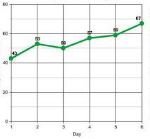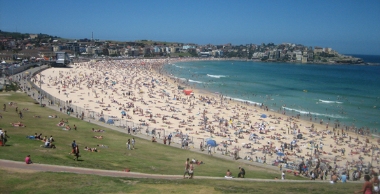Some of the first things people do when they go an a health kick and try to lose weight, such as eating more fruit and drinking more water, can actually cause you to struggle to lose weight. Here are 5 so called “healthy habits” which could be preventing you from losing weight.
 Drinking water
Drinking water
Getting enough water is definitely essential to good health, helping you to stay hydrated and full of energy, and keeping all the cells in your body (including those in your digestive system) in good shape. Studies have shown however, that some of the chemicals found in drinking water could also be making you fat.
The chemical BPA, still found in some plastic water bottles, encourages the body to make more fat. But don’t feel too smug if your drinking vessel is BPA free. Studies have also shown that our drinking water can also contain the hormone oestrogen, which effects the way are bodies store fat. The more exposure to these chemicals, the harder it is to lose weight.
This isn’t an excuse to drink wine instead of water though! Just switch to filtered water and you’ll be fine. Do steer away from too much bottled water, as it may not contain the mineral content you’ll find in tap water. Your standard tap filter generally won’t filter out trace minerals found in water, but make sure you read the fine print before you buy.
 Snacking on Fruit
Snacking on Fruit
Packed with fibre, antioxidants and other vitamins and minerals, fruits have undoubted health benefits. However, less is more when it comes to fruit and weight loss. Many people overindulge in fruits, fruit juices and smoothies, forgetting that fruits are not only packed with micro nutrients, but also calories. A calorie is still a calorie, no matter how healthy, and you’re just as likely to get fat eating too much fruit, as you are eating too much of anything else. I recall a number of conversations with clients who’ve lamented that they are eating “healthily” yet are not able to lose weight. Very often, too much fruit is the culprit, in one case, about six pieces a day.
Fructose, the sugar found in fruit, has been found to be a possible trigger in overeating. After eating fructose, the brain doesn’t register the same feelings of fullness as it does when we consume glucose. So the message is, fruit is important for its nutrients, but don’t go overboard. If your aim is weight loss, two pieces of fruit a day is the limit, and these should be consumed as whole fresh fruit, not fruit juice, so that you get the benefits of the fibre found in fruit as well. If you’re a big fruit eater, try swapping some of your fruit for vegetables such as carrot and capsicum sticks.
 Cutting fat from your diet
Cutting fat from your diet
If you’ve ever tried to lose weight, I’m guessing you will have rejected a food based on the fat content written on the packet. Conversely, you may have bought a food based on its perceived low fat content. “99% fat free” has a very attractive ring to it if you are trying to lose weight.
Low fat options are often not the best, for a number of reasons. Firstly, some of the fatty acids removed from food to make it low fat, actually help our bodies break down fat. Secondly, low fat options are often packed with sugar to compensate for the loss in flavour which can accompany the removal of fat. It’s back to the number of calories thing again, isn’t it? And lastly, some studies have found that eating fats that are good for you-monounsaturated fats found in olives, nuts and avocados, can actually help promote weight loss.
 Exercise
Exercise
Whilst exercise is not going to make you fat, and it is essential for good health, there are two classic mistakes people make when it comes to exercise and weight loss.
The first is thinking that exercise alone will give you the weight loss you are after. Of course, it is possible to lose weight simply by increasing your exercise levels. To see any significant weight loss from exercise alone, however, you would need to increase the amount of moderate intensity exercise you do by about an hour a day to create an energy deficit. This is certainly doable, but not advisable, if you are looking to see short term results. Increasing your level of exercise by an hour a day from one day to the next is just not the way to go. You should build your exercise volume and intensity gradually to reduce the risk of injury.
Also, people tend to over estimate the amount of exercise they do, and feel they can “reward” themselves for exercising, by eating some kind of calorie laden treat, leading to weight gain. For maximum benefits, increase the amount of exercise you are doing, and develop healthy eating habits.
 Being Positive
Being Positive
Whilst being positive may make you happier and boost your immune system, research suggests that optimistic people may have more trouble losing weight.
Research by America’s National Institute on Ageing, shows that impulsivity is the strongest predictor of who will become overweight.
In another study, Japanese researchers from DoshishaUniversity studied obese women and men participating in a six month weight loss program. They found the people who were more positive in their outlook lost the least amount of weight. It is thought that being positive and optimistic means that you won’t worry enough about your weight to be able to resist temptation and stick to healthy eating and fitness regimes. If this sounds like you, it’s a good idea to make sure you incorporate exercise that you like doing as part of your lifestyle. A support system such as training with friends or in a group environment can be an absolute boon if you’re so happy you struggle to stick at it!
Photos courtesy of Freedigitalphotos.net


 Drinking water
Drinking water Snacking on Fruit
Snacking on Fruit Cutting fat from your diet
Cutting fat from your diet Exercise
Exercise Being Positive
Being Positive







 Stroke is the second biggest killer amongst Australians, yet many of us would not be able to recognise the symptoms of stroke if we saw them. The Australian goverment recently announced $2m in funding to promote awareness of the F.A.S.T campaign, aimed at helping people to recognise the symptoms of stroke.
Stroke is the second biggest killer amongst Australians, yet many of us would not be able to recognise the symptoms of stroke if we saw them. The Australian goverment recently announced $2m in funding to promote awareness of the F.A.S.T campaign, aimed at helping people to recognise the symptoms of stroke.